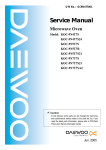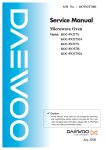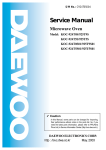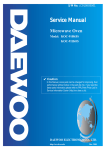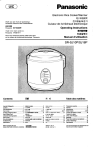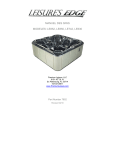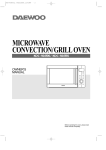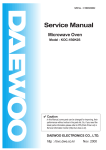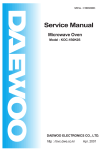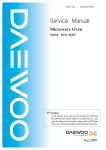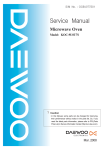Download Zanussi FV 850 N Service manual
Transcript
SERVICE MANUAL MICROWAVE OVENS Microwave Oven © ELECTROLUX HOME PRODUCTS Corso Lino Zanussi,30 I - 33080 PORCIA /PN (ITALY) Tel +39 0434 394850 Fax +39 0434 394096 Publication No. EMC3065X (947608328) 599 38 84-81 EN/SERVICE/FV SOI Edition: 05.2007 SOI 05.07 FV 599 38 84-81 PRECAUTIONS TO BE OBSERVED BEFORE AND DURING SERVICING TO AVOID POSSIBLE EXPOSURE TO EXCESSIVE MICROWAVE ENERGY (a) Do not operate or allow the oven to be operated with the door open. (b) Make the following safety checks on all ovens to be serviced before activating the magnetron or other microwave source, and make repairs if necessary: (1) Interlock operation, (2) Proper door closing, (3) Seal and sealing surfaces (arcing, wear, and other damage), (4) Damage to or loosening of hinges and latches (5) Evidence of dropping or abuse. (c) Before turning on power to the microwave oven for any service test or inspection within the microwave generating compartments, check the magnetron, wave guide or transmission line, and cavity for proper alignment, integrity, and connections. (d) Any defective or misadjusted components in the interlock, monitor, door seal and microwave generation and transmission systems shall be repaired, replaced, or adjusted by procedures described in this manual before the oven is released to the owner. TABLE OF CONTENTS 1. SAFETY AND PRECAUTIONS....................................................................................................................................3 2. SPECIFICATIONS ........................................................................................................................................................4 3. EXTERNAL VIEW.........................................................................................................................................................5 3-1. OUTER DIMENSION ..........................................................................................................................................5 3-2. FEATURE DIAGRAM .........................................................................................................................................6 4. INSTALLATION ............................................................................................................................................................7 5. CONTROL PANEL .......................................................................................................................................................8 6. DISASSEMBLY AND ASSEMBLY ..............................................................................................................................8 7. INTERLOCK MECHANISM AND ADJUSTMENT.....................................................................................................18 8. TROUBLE SHOOTING GUIDE ..................................................................................................................................19 9. MESUREMENT AND TEST .......................................................................................................................................24 9-1. MEASUREMENT OF THE MICROWAVE POWER OUTPUT ........................................................................24 9-2. MICROWAVE RADIATION TEST ....................................................................................................................25 9-3. COMPONENT TEST PROCEDURE................................................................................................................26 9-4. COMPONENT ACTION....................................................................................................................................27 10. WIRING DIAGRAM...................................................................................................................................................28 2 1. SAFETY AND PRECAUTIONS 1. FOR SAFE OPERATION Damage that allows the microwave energy (that cooks or heats the food) to escape will result in poor cooking and may cause serious bodily injury to the operator. IF ANY OF THE FOLLOWING CONDITIONS EXIST, OPERATOR MUST NOT USE THE APPLIANCE. (Only a trained service personnel should make repairs.) (1) A broken door hinge. (2) A broken door viewing screen. (3) A broken front panel, oven cavity. (4) A loosened door lock. (5) A broken door lock. The door gasket plate and oven cavity surface should be kept clean. No grease, soil or spatter should be allowed to build up on these surfaces or inside the oven. DO NOT ATTEMPT TO OPERATE THIS APPLIANCE WITH THE DOOR OPEN. The microwave oven has concealed switches to make sure the power is turned off when the door is opened. Do not attempt to defeat them. DO NOT ATTEMPT TO SERVICE THIS APPLIANCE UNTIL YOU HAVE READ THIS SERVICE MANUAL. 2. FOR SAFE SERVICE PROCEDURES. 1. If the oven is operative prior to servicing, a microwave emission check should be performed prior to servicing the oven. 2. If any certified oven unit is found to servicing, a microwave emission check should be performed prior to servicing the oven. (1) inform the manufacturer, importer or assembler, (2) repair the unit at no cost to the owner, (3) attempt to ascertain the cause of the excessive leakage, (4) tell the owner of the unit not to use the unit until the oven has been brought into compliance. 3. If the oven operates with the door open, the service person should tell the user not to operate the oven and contact the manufacturer immediately. IMPORTANT The wire in this mains lead coloured in accordance with the following code. Green-and-yellow : Earth Blue : Neutral Brown : Live As the colours of the wires in the mains lead of this appliance may not correspond with the coloured markings identifying the terminals in your plug, proceed as follows: The wire which is coloured green-and-yellow must be connected to the terminal in the plug which is marked with the letter E , earth symbol or coloured green-and-yellow. The wire which is coloured blue must be connected to the terminal which is marked with the letter N or coloured black. The wire which is coloured brown must be connected to the terminal which is marked with the letter L or coloured red. NOTE : This oven is designed for counter-top use only. 3 2. SPECIFICATIONS KOC-9N4T7S, 9N4T7S24, MODEL POWER SUPPLY 230V~50Hz, SINGLE PHASE WITH EARTHING MICROWAVE POWER CONSUMPTION KOC-9N5T7R 9N5T7S, 9N5T7S21 1450W GRILL 850W CONVECTION 2250W 1450W COMBINATION 2950W 1450W MICROWAVE ENERGY OUTPUT 900W (IEC 705) MICROWAVE FREQUENCY 2450MHz OUTSIDE DIMENSIONS (W X H X D) 542X329X515mm(21.3X13.0X20.3 in.) CAVITY DIMENSIONS (W X H X D) 350X230X355mm(13.8X9.1X14.0 in.) NET WEIGHT Approx. 18Kg (39.6 lbs.) TIMER 60 minutes FUNCTION SELECTIONS Microwave / Grill / Convection / Combination POWER SELECTIONS 10 LEVELS CAVITY VOLUME 1.0 Cu. Ft * SPECIFICATION ARE SUBJECT TO CHANGE WITHOUT NOTICE. 4 3. EXTERNAL VIEW 1. OUTER DIMENSION 1)KOC-9N4T/9N5T 5 2. FEATURE DIAGRAM 11. DOOR HOOK When the door is closed, it will automatically lock shut. If door is opened while oven is operating, the magnetron will immediately stop operating. 12. DOOR VIEWING SCREEN Allows viewing of food. The screen is designed so that light can pass through, but not the microwave. 13. METAL RACK 14. TOP HEATER Turns on when convection, grill and combi cooking is selected. 15. OVEN LAMP Automatically turns on during oven operating. 16. SAFETY INTERLOCK SYSTEM 17. CONTROL PANEL 18. TURNTABLE TRAY Rotates during cooking and ensure even distribution of Microwaves. It can also be used as a cooking utensil. 19. ROLLER GUIDE This must always be used for cooking together with the turntable tray. 10. COUPLER This fits over the shaft in the center of the ovens cavity floor. This is to remain in the oven for all cooking. 11. CONVECTION OUTLET & FAN 12. OVEN FRONT PLATE 13. DOOR SEAL Door seal maintains the microwave energy within the oven cavity and prevents microwave leakage. 14. BARBECUE BAR (KOC-9N7T7SA2 ONLY) This is used barbecue cooking. 6 4. INSTALLATION 1. Steady, flat location This microwave oven should be set on a steady, flat surface. This microwave oven is designed for counter top use only. 2. Leave space behind and side All air vents should be kept a clearance. If all vents are covered during operation, the oven may overheat and, eventually, cause failure. 3. Away from Radio and TV sets Poor television reception and radio interference may result if the oven is located close to a TV, Radio, antenna or feeder and so on. Position the oven as far from them as possible. 4. Away from heating appliances and water taps Keep the oven away from hot air, steam or splash when choosing a place to position it, or the insulation might be adversely affected and breakdowns occur. 5. Power supply Check your local power source. This microwave oven requires a current of approximately 13 amperes, 230V, 50Hz. Power supply cord is about 1.0 meters long. The voltage used must be the same as specified on this oven. Using a higher voltage may result in a fire or other accident causing oven damage. Using low voltage will cause slow cooking. We are not responsible for damage resulting from use of this oven with a voltage of ampere fuse other than those specified. This appliance is supplied with cable of special type, which, if damaged, must be repaired with cable of same type. Such a cable can be purchased from DAEWOO and must be installed by a Qualified Person. 6. Examine the oven after unpacking for any damage such as: A misaligned door, broken door or a dent in cavity. If any of the above are visible, DO NOT INSTALL, and notify dealer immediately. 7. Do not operate the oven if it is colder than room temperature. EARTHING INSTRUCTIONS This appliance must be earthed. In the event of an electrical short circuit, earthing reduces the risk of the electric shock by providing an escape wire for the electric current. This appliance is equipped with a cord having a earthing wire with a earthing plug. The plug must be plugged into an outlet that is properly installed and earthed. WARNING Improper use of the earthing plug can result in a risk of electric shock. Consult a qualified electrician of serviceman if the earthing instructions are not completely understood, or if doubt exists as to whether the appliance is properly earthed, and either: If it is necessary to use an extension cord, use only a 3-wire extension cord that has a 3-blade earthing plug, and a 3-slot receptacle that will accept the plug on the appliance. The marked rating of the extension cord should be equal to or greater than the electrical rating of the appliance, or Do not use an extension cord. 7 5. CONTROL PANEL 1 Display : Cooking time, power level, indicators and present time are displayed. MW : When blinking, the oven is operating in MICROWAVE COOK. Grill : When blinking, the oven is operating in GRILL. Combi : When blinking, the oven is operating in COMBI. Defrost Weight : When blinking, the oven is operating in WEIGHT DEFROST. Time : When blinking, the oven is operating in TIME DEFROST. Auto-cook : When blinking, the oven is operating AUTO COOK. Lock : When lighting, the oven is CHILD LOCK. Con-vection : When blinking, the oven is operating in CONVECTION. g : When blinking, the oven is operating in weight input mode. Barbecue : When blinking, the oven is operating in barbecue. (KOC-9N7T7SA2 only) 2 Auto cook : Used to cook or reheat. 3 Combi : Used to select combi. 4 Weight Defrost : Press to select the weight defrosting cooking. (KOC-9N4T7S/9N4T7S24/9N5T7S/9N5T7R/ 9N5T7S21/9N7T7S/9N7T7S21 only) Auto Defrost : Press to select the auto defrosting cooking. (KOC-9N7T7SA2 only) 5 Grill : Used to select grill. 6 MW : Used to set power level of micro wave. 7 Time Defrost : Press to select the time defrosting cooking. (KOC-9N4T7S/9N4T7S24/9N5T7S/9N5T7R/ 9N5T7S21/9N7T7S/9N7T7S21 only) Barbecue : Press to select the barbecue cooking. (KOC-9N7T7SA2 only) 8 Convection : Used to select convection and selected temp. 9 Clock : Used to set clock. 0 Dial knob : Used to set time, weight and quantity. q START/SPEEDY COOK : Used to start a programmed, also for speedy start(each press adds 30 seconds microwave cooking time). w STOP/CLEAR : Used to stop the oven operation or to delete the cooking data. 8 6. DISASSEMBLY AND ASSEMBLY - Cautions to be observed when trouble shooting. Unlike many other appliances, the microwave oven is high-voltage, high-current equipment. It is completely safe during normal operation. However, carelessness in servicing the oven can result in an electric shock or possible danger from a short circuit. You are asked to observe the following precautions carefully. 1. Always remove the power plug from the outlet before servicing. 2. Use an insulated screwdriver and wear rubber gloves when servicing the high voltage side. 3. Discharge the high voltage capacitor before touching any oven components or wiring. (1) Check the grounding. Do not operate on a two-wire extension cord. The microwave oven is designed to be used while grounded. It is imperative, therefore, to make sure it is grounded properly before beginning repair work. (2) Warning about the electric charge in the high voltage capacitor. For about 30 seconds after the operation has stopped, electric charge remains in the high voltage capacitor. When replacing or checking parts, short between oven chassis and the negative high terminal of the high voltage capacitor by using a properly insulated screwdriver to discharge. 4. When the fuse is blown out due to the operation of the monitor switch; replace primary interlock switch, secondary interlock switch and interlock monitor switch. 5. After repair or replacement of parts, make sure that the screws are properly tightened, and all electrical connections are tightened. 6. Do not operate without cabinet. CAUTION : Service personnel should remove their watches whenever working close to or replacing the magnetron. WARNING : When servicing the appliance, take care when touching or replacing high potential parts because of electrical shock or exposing microwave. These parts are as follows - HV Transformer, Magnetron, HV Capacitor, HV Diode. 9 1. To remove cabinet 1) Remove four screws on cabinet back. 2) Push the cabinet backward. 2. To remove door assembly 1) Remove two screws which secure the stopper hinge top. 2) Remove the door assembly from top plate of cavity. 3) Reverse the above for assemby. NOTE: After replacing the door assembly, perform a check of correct alignment with the hinge and cavity front plate. 10 ✔ Caution : In this Manual, some parts can be changed for improving, their performance without notice in the parts list. So, if you need the latest parts information, please refer to PPL(Parts Price List) in Service Information Center 3. To remove door parts. 1) KOC-9N4T/9N5T A10 A09 A08 A07 A11 A12 A04 A05 A06 A03 A13 A02 A01 REF NO. A01 A02 A03 A04 A05 A06 A07 A08 A09 A10 A11 A12 A13 PART CODE 3512603620 3511608300 3512204820 7001503011 3515101800 3513101200 3512302400 3516602200 3515304800 3517007120 3517007130 3511608700 3511608400 3511608200 PART NAME HANDLE DOOR DECORATOR DOOR*R FRAME DOOR SCREW MACHINE SPRING HOOK HOOK GASKET DOOR DOOR PLATE SUPPORTER HINGE*T BARRIER-SCREEN *O BARRIER-SCREEN *O DECORATOR DOOR*T DECORATOR DOOR*L DECORATOR DOOR*U DESCRIPTION S455C SUS430 T0.5 H/L ALLOY PC+ABS PAN 5*30 MFZN PW1 POM PBT SBHG-3A T0.7 SCP-1 T2.0 GLASS T3.2 GLASS T3.2 MIRROR SUS430 T0.5 H/L SUS430 T0.5 H/L SUS430 T0.5 H/L (1) Remove the gasket door from door plate. (2) Remove the door frame from door plate. (3) Remove screws from door frame. (4) Remove the handle from door frame. (5) Remove the decorator door from door frame. (6) Remove the stopper hinge top from door plate. (7) Remove the spring and the hook. (8) Remove barrier screen outer from door frame. (9) Reverse the above steps for reassembly. 11 Q’TY 1 1 1 2 1 1 1 1 1 1 1 1 1 1 REMARK KOC-9N4T7S24 ONLY 4. Method to reduce the gap between the door seal and the oven front surface. (1) To reduce gap located on part ‘A’. • Loosen two screws on stopper hinge top, and then push the door to contact the door seal to oven front surface. • Tighten two screws. (2) To reduce gap located on part ‘B’. • Loosen two screws on stopper hinge under, and then push the door to contact the door seal to oven front surface. • Tighten two screws. NOTE : A small gap may be acceptable if the microwave leakage does not exceed 4mW/cm2. 12 ✔ Caution : In this Manual, some parts can be changed for improving, their performance without notice in the parts list. So, if you need the latest parts information, please refer to PPL(Parts Price List) in Service Information Center 2) KOC-9N5T7S,9N5T7R,9N5T7S21 REF NO. B01 B02 B03 B04 B05 B06 B07 B08 B09 B10 B11 PART CODE 3513406330 3515501820 3511608110 3516005600 3516725260 3516909080 71222401211 PART NAME KNOB VOLUME WINDOW DISPLAY DECORATOR C-PANEL SPECIAL DOUBLE TAPE CONTROL-PANEL BUTTON FUNCTION-A SCREW TAPPING T2S DESCRIPTION ABS SG-175 SG-0760D PMMA SUS430 T0.5 H/L HOSTIC 550M(D)TO.15 ABS XR-401 SG-0320G ABS SG-175 SG-0760D SPRAY TRS 4*12 MFZN Q’TY 1 1 1 1 1 1 4 PKMPMSA200 PCB MAIN AS KOC-9N4T7S 1 PKMPMSA220 7121301011 PKBPMSA200 3516909090 PCB MAIN AS SCREW TAPPING PCB SUB AS BUTTON FUNCTION-B KOC-9N5T7R T2S PAN 3*10 MFZN KOC-9N4T7S ABS SG-175 SG-0760D SPRAY 1 5 1 1 REMARK KOC-9N5T7S, 9N5T7S21 KOC-9N5T7R (1) Remove the screw which secure the control panel, push up two snap fits and draw forward the control panel assembly. (2) Remove four screws(B07) which secure the PCB Main ASS’Y. (3) Pull out the Main PCB assembly(B08). (4) Remove four screws(B09) which secure the PCB Sub ASS’Y. (5) Pull out the Sub PCB assembly(B10). (6) Pull out the Knob volume(B01) from the Sub PCB assembly. (7) Pull out ten buttons from the control panel. (8) Pull out Decorator control panel(B03) from the control panel. (9) Pull out Window display(B02) from the control panel. (10)Reverse the above steps for reassembly. 13 6. To remove high voltage capacitor. 1) Remove a screw which secure the grounding ring terminal of the H.V. diode and the capacitor holder. 2) Remove the H.V. diode from the capacitor holder. 3) Reverse the above steps for reassembly. High voltage circuit wiring 7. To remove magnetron. 1) Remove a screw which secure the magnetron. 2) Remove the magnetron. 3) Reverse the above steps for reassembly. CAUTION : Never install the magnetron without the metallic gasket plate which is packed with each magnetron to prevent microwave leakage. Whenever repair work is carried out on magnetron, check the microwave leakage. It shall not exceed 4mW/cm2 for a fully assembled oven with door normally closed. Metallic gasket plate Cooling fin Magnetron antenna Filament terminal <MAGNETRON> 14 8. To remove wind guide assembly. 1) Remove a screw for earthing. 2) Remove the noise filter from the wind guide. 3) Remove a screw which secure the wind guide assembly. 4) Draw forward the wind guide assembly. 5) Pull the fan from the motor shaft. 6) Remove two screws which secure the motor shaded pole. 7) Remove the motor shaded pole. 8) Reverse the above steps for reasembly. 9. To remove H.V.transformer. 1) Remove four screws holding the H.V.transformer. 2) Remove the H.V.transformer. 3) Reverse the above steps for reassembly. 15 ✔ Caution: In this Service Manual, some parts can be changed for improving, their performance without notice in the parts list. So, if you need the latest parts information, please refer to PPL(Parts Price List) in Service information Center 10. To remove Top heater assembly parts. 5 REF NO. 1 2 3 4 5 6 7 PART CODE 7112401011 3512520500 3512804900 7112401011 3510607700 3512805800 3511410300 6 7 PART NAME SCREW TAPPING GUIDE AIR OUTLET HEATER REFLECTOR SCREW TAPPING BRACKET HEATER *T HEATER MIRACLON COVER HEATER *T 1 234 DESCRIPTION T1 TRS 4X10 MFZN SA1D T0.5 STS430 T0.5 T1 TRS 4X10 MFZN SA1D T0.5 230V 800W 270MM SA1D T0.5 1) Remove a screw 1 and pull out Guide air outlet 2 . 2) Remove screws 9 and pull out braket heater *T 6 . 3) Pull out heater miraclon 7 . 4) Remove two screws 4. 5) Pull out the heater reflector 3 from cover heater *T 8. 6) Reverse the above steps for reassembly. 16 Q’TY 1 1 1 2 2 1 1 REMARK ✔ Caution: In this Service Manual, some parts can be changed for improving, their performance without notice in the parts list. So, if you need the latest parts information, please refer to PPL(Parts Price List) in Service information Center 11. To remove Rear heater assembly parts. 14 13 12 11 10 15 9 8 16 17 7 6 1 5 4 3 2 REF NO. 1 PART CODE 7112401011 PART NAME SCREW TAPPING DESCRIPTION T1 TRS 4*10 MFZN 2 3 4 5 6 7 3511407300 7112401011 3511407900 3512767611 7113400814 3513303400 COVER MOTOR*B SCREW TAPPING COVER*B HARNESS CONVECTION SCREW TAPPING INSULATOR HEATER*B SA1D-80 T0.5 T1 TRS 4*10 MFZN SA1D-80 T0.5 KOC-924T0S ALTERNATE T1 BIN 4*8 MFNI SBHG-1 T0.5 1 1 1 1 4 1 8 9 10 11 12 13 14 15 16 17 3511409800 7113400814 3511800700 3513002300 3512801800 7400104011 7601400811 3963514330 3511800900 7402704600 COVER HEATER*B SCREW TAPPING FAN CONVECTION HOLDER HEATER HEATER WASHER PLAIN SCREW MACHINE MOTOR SHADED POLE FAN RING C SA1D-80 T0.5 T1 BIN 4*8 MFNI SA1D-80 T0.5 SUS 304 T0.5 230V 1400W 1R18344 PW-1-4 MFZN PAN 4*8 SW MFZN 230V 50Hz MW10CA-T03 PBT CR-5 SK5 1 3 1 3 1 1 2 1 1 1 1) Remove a screw 1 and pull out Cover motor *B 2. 2) Remove a screw 3 and pull out Cover *B 4. 3) Pull out the Harness convection-B 5. 4) Remove four screws 6 and then pull out the Rear heater assembly. 5) Remove a Nut e and the pull out the Fan convection 0. 6) Remove three screws 9 and then separate the Cover heater *B 7 and the lnsulator heater *B 8. 7) Pull out the Heater w from the Cover Heater *B 7. 8) Remove two screw r and then separate the lnsulator heater *B 8 and Motor shaded pole t. 9) Remove the C-Ring u and then pull out the Fan y from Motor shaft. 10)Reverse the above steps for reassebly. 17 Q TY 1 REMARK 7. INTERLOCK MECHANISM AND ADJUSTMENT The door lock mechanism is a device which has been specially designed to completely eliminate microwave radiation when the door is opened during operation, and thus to perfectly prevent the danger resulting from the leakage of microwave. (1) Primary interlock switch When the door is closed, the hook locks the oven door. If the door is not closed properly, the oven will not operate. When the door is closed, the hook pushes the button of the microswitch. Then the button of the primary interlock switch bring it under ON condition. (2) Secondary interlock switch and interlock monitor switch When the door is closed, the hook pushes the lock lever downward. The lock lever presses the button of the interlock monitor switch to bring it under OFF condition and presses the button of the secondary interlock switch to bring it under ON condition. ADJUSTMENT : Interlock monitor switch When the door is closed, the interlock monitor switch should be opened before other switches are closed. When the door is opened, the interlock monitor switch should be closed after other switches are opened. (3) Adjustment steps a) Loosen the one mounting screw. b) Adjust interlock switch assembly position. c) Make sure that lock lever moves smoothly after adjustment is completed. d) Tighten completely two mounting screws. NOTE : Microwave emission test should be performed after adjusting interlock mechanism. If the microwave emission exceed 4mW/cm2, readjust interlock mechanism. 18 8. TROUBLE SHOOTING GUIDE Following the procedure below to check if the oven is defective or not. 1) Check grounding before trouble checking. 2) Be careful of the high voltage circuit. 3) Discharge the high voltage capacitor. 4) When checking the continuity of the switches, fuse or high voltage tranformer, disconnect one load wire from these parts and check continuity with the AC plug removed. To do otherwise may result in a false reading or damage to your meter. NOTE : When electric parts are checked, be sure the power cord is not inserted the wall outlet. Check wire harness, wiring and connection of the terminals and power cord before check the parts listed below. (TROUBLE 1) Oven does not operate at all : any inputs can not be accepted. CONDITION Fuse blows. CHECK Check continuity of interlock monitor switch with door closed ( COM NC ) RESULT Continuity (COM NC) CAUSE Malfunction of Interlock monitor switch REMEDY Replace No continuity No Continuity Check continuity of both primary and secondary interlock switch with door closed Malfunction of interlock switch Replace Continuity Continuity Check continuity of primary interlock switch contact with door partially open until interlock monitor switch contact close ( COM NC close ) Check continuity of primary winding of low voltage transformer or infinite Approx. 480 ~620 ( normal ) Fuse again blows Disconnect high voltage fuse and operate the unit 19 Shorted contacts of primary interlock Switch Defective low voltage transformer Defective high voltage transformer Replace Replace Replace CONDITION CHECK RESULT CAUSE REMEDY Outlet has proper voltage fuse does not blow? Check continuity of magnetron No continuity Defective magnetron. Replace Check continuity of noise filter board No continuity Defective line filter board Replace Check continuity of power supply cord No continuity Open power supply cord Replace No continuity Defective touch control circuit Replace NOTE : All these switches must be replaced at the same time, please refer to (7.Interlock mechanism and adjust) for adjustment instructions (TROUBLE 2) Display shows all figures selected, but oven does not start cooking, even though desired program and time are set and start button is tapped. CONDITION CHECK RESULT CAUSE REMEDY Turn table motor and oven lamp do not turn on Check continuity of primary interlock switch No continuity Malfunction of primary interlock switch Adjust or replace Check continuity of secondary interlock and D.O.M switch No continuity Malfunction of secondary Interlock and D.O.M switch Adjust or replace Check D.C voltage being supplied to RELAY(RY4) coil 0V Defective touch control Circuit Replace Approx. 24V DC Fault contacts of RELAY (RY4) or open relay coil. Replace 20 TROUBLE 3) No microwave oscillation even though fan motor rotates. CONDITION CHECK RESULT CAUSE REMEDY No microwave oscillation Check continuity of high voltage fuse No continuity Defective high voltage fuse Replace Check continuity of high voltage capacitor terminals with wires removed Continuity Defective high voltage transformer 1 Check continuity of high voltage rectifier in forward and backward direction with DC megger Continuity in backward direction Defective high voltage rectifier Replace No microwave oscillation Connect megger leads to magnetron terminal and magnetron body Continuity Defective magnetron 2 Check D.C voltage being supplied to RELAY (RY1) coil 0V Defective touch control circuit Replace Approx. 24V DC Faulty contacts of RELAY (RY1) or open relay coil Replace Defective high voltage transformer Replace Defective high voltage transformer Replace Defective magnetron Replace 0 1 Check resistance of primary or and secondary coil of high voltage transformer 1 Check continuity of filament No continuity terminal of high voltage transformer 2 Check continuity of magnetron heater with wires removed No continuity 21 (TROUBLE 4) Grill heater (upper heater) is not heated; food will not become hot. CONDITION Grill heater is not heated. CHECK RESULT CAUSE REMEDY Check continuity of primary interlock switch No continuity Malfunction of primary Interlock switch Adjust or replace Check continuity of secondary interlock switch No continuity Malfunction of secondary interlock switch Adjust or replace Check continuity of heater No continuity Defective heater Check D.C voltage being supplied to RELAY (RY2) coil 0V Defective touch control circuit Replace Approx. 24V DC Faulty contacts of RELAY (RY2) or open relay coil Replace Replace (TROUBLE 5) 1) Convection heater is not heated; food will not become hot. 2) Convection fan motor does no rotate. CONDITION CHECK RESULT CAUSE REMEDY 1)Convection heater is not heated. 2)Convection fan and motor does not rotate. Check continuity of primary interlock switch No continuity Malfunction of primary Interlock switch Adjust or replace Check continuity of secondary interlock switch No continuity Malfunction of secondary interlock switch Adjust or replace Check continuity of (heater or motor) No continuity Defective motor Check D.C voltage being supplied to RELAY (RY3, RY6) coil 0V Defective touch control circuit Replace Approx. 24V DC Faulty contacts of RELAY (RY3,RY6) or open relay coil Replace 22 Replace (TROUBLE 6) The following visual conditions inditions indicate a probable defective touch control Circuit or button P.C.B. assembly 1. Incomplete segments. 1) segment missing 2) partial segments missing 3) digit flickering other than normal fluorescent slight flickering 2. A distinct change in the brightness of one or more numbers exists in the display. 3. One or more digits in the display are not on when they should be. 4. Display does not count down or up with time cooking or clock operation. 5. Oven is programmable and cooks normally but no display shows. 6. Display obviously jumps in time while counting down. 7. Display counts down noticeably too fast while cooking. 8. Display does not show the time of day when clear button is touched. 9. Oven lamp and turn table motor do not stop although cooking is finished. Check if the RELAY(RY4) contacts close and if they are close, replace touch control circuit. CONDITION CHECK Display does not show programming at all, even if keyboard is touched. Check each button for continuity of the button RESULT CAUSE REMEDY Malfunction of sub pcb assembly Replace control box sub-assembly CAUSE REMEDY Replace Replace No continuty Defective heater Replace continuity Defective touch control circuit Replace Normal (TROUBLE 7) When ERROR 2 ERROR 3 come on display. CONDITION CHECK ERROR 2 & ERROR 3 come on display Check continuity of thermistor (resistance of thermistor) RESULT 0 or infinite Approx 200~300k (room temperature) Check continuity of heater (convection, upper, lower) 23 9. MEASUREMENT AND TEST 1. MEASUREMENT OF THE MICROWAVE POWER OUTPUT Microwave output power can be checked by indirectly measuring the temperature rise of a certain amount of water exposed to the microwave as directed below. PROCEDURE 1. A cylindrical container of borosilicate glass is used for the test. It has a maximum thickness of 3mm, an external diameter of approximately 190mm and a height of approximately 90mm. The mass of the container is determined. 2. At the start of the test, the oven and the empty container are at ambient temperature. Water having an initial temperature of 10 C 1 C is used for the test. The water temperature is measured immediately before it is poured into the container. 3. A quantity of 1000g 5g of water is added to the container and its actual mass obtained. The container is then immediately placed in the centre of the oven shelf, which is in its lowest normal position. The oven is operated and the time for the water temperature to attain 20 C 2 C is measured. The oven is then switched off and the final water temperature is measured within 60s. NOTE 1 - The water stirred is before its temperature is measured. NOTE 2 - Stirring and measuring devices are to have a low heat capacity. 4. The microwave power output is calculated from the formula P = 4,187 mW (T2 -T1) + 0.55 mC(T2 - T0)/t where P is the microwave power output, in watts ; mW is the mass of the water, in grams ; mc is the mass of the container, in grams ; T0 is ambient temperature, in degrees Celsius ; T1 is the initial temperature of the water, in degree Celsius ; T2 is the final temperature of the water, in degrees Celsius ; t is the heating time, in seconds, excluding the magnetron filament heating-up time. The microwave power output is stated in watts, rounded off to the nearest 50W CAUTION 1. Water load should be measured exactly to 1 liter. 2. Input power voltage should be exactly specified voltage (Refer to SPECIFICATIONS). 3. Ambient temperature should be 20 2 C (68 3.6 F) Heating time for power output: (T2 = T0) A (second) 70 64 60 56 52 49 47 44 42 40 38 B (W) 600 650 700 750 800 850 900 950 1000 1050 1100 24 2. MICROWAVE RADIATION TEST WARNING 1. Make sure to check the microwave leakage before and after repair of adjustment. 2. Always start measuring of an unknown field to assure safety for operating personnel from microwave energy. 3. Do not place your hands into any suspected microwave radiation field unless the safe density level is known. 4. Care should be taken not to place the eyes in direct line with the source of microwave energy. 5. Slowly approach the unit under test until the radiometer reads an appreciable microwave leakage from the unit under the test. PROCEDURE 1. Prepare Microwave Energy Survey Meter, 600cc glass beaker, and glass thermometer 100 C (212 F). 2. Pour 275cc 15cc of tap water initially at 20 5 C (68 9 F) in the 600 cc glass beaker with an inside diameter of approx. 95 mm(3.5 in.). 3. Place it at the center of the tray and set it in a cavity. 4. Close the door and operate the oven. 5. Measure the leakage by using Microwave Energy Survey Meter with dual ranges, set to 2450MHz. 1) Measured radiation leakage must not exceed the value prescribed below. Leakage for a fully assembled oven with door normally closed must be less than 4mW/Cm2. 2) When measuring the leakage, always use the 5 cm (2 in.) space cone with probe. Hold the probe perpendicular to the cabinet and door. Place the space cone of the probe on the door, cabinet, door seem, door viewing screen, the exhaust air vents and the suction air vents. 3) Measuring should be in a counter-clockwise direction at a rate of 1 in./sec. If the leakage of the cabinet door seem is unknown, move the probe more slowly. 4) When measuring near a corner of the door, keep the probe perpendicular to the areas making sure the probe end at the base of the cone does not get closer than 2 in. from any metal. If it does not, erroneous reading may result. 25 3. COMPONENT TEST PROCEDURE High voltage is present at the high voltage terminal of the high voltage transformer during any cooking cycle. It is neither necessary nor advisable to attempt measurement of the high voltage. Before touching any oven components or wiring, always unplug the oven from its power source and discharge the capacitor. 1. High voltage transformer 1) Remove connections from the transformer terminals and check continuity. 2) Normal readings should be as follows : Secondary winding ... Approx. 100 10% Filament winding ... Approx. 0 Primary winding ... Approx. 1.2 2. High voltage capacitor 1) Check continuity of capacitor with meter on the highest OHM scale. 2) A normal capacitor will show continuity for a short time, and then indicate 10M 3) A shorted capacitor will show continuous continuity. 4) An open capacitor will show constant 10M . 5) Resistance between each terminal and chassis should be infinite. once the capacitor charged. 3. High voltage diode 1) Isolate the diode from the circuit by disconnecting the leads. 2) With the ohmmeter set on the highest resistance scale measure the resistance across the diode terminals. Reverse the meter leads and again observe the resistance reading. Meter with 6V, 9V or higher voltage batteries should be used to check the front-back resistance of the diode, otherwise an infinite resistance may be read in both directions. A normal diode’s resistance will be infinite in one direction and several hundred k in the other direction. 4. Magnetron For complete magnetron diagnosis, refer to "Measurement of the Microwave Power Output." Continuity checks can only indicate and open filament or a shorted magnetron. To diagnose for an open filament or a shorted magnetron, 1) Isolate magnetron from the circuit by disconnecting the leads. 2) A continuity check across magnetron filament terminals should indicate 0.1 or less. 3) A continuity check between each filament terminal and magnetron case should read open. 5. Fuse If the fuse in the primary and monitor switch circuit is blown when the door is opened, check the primary and monitor switch before replacing the blown fuse. In case the fuse is blown by an improper switch operation, replace the defective switch and fuse at the same time. Replace just the fuse if the switches operate normally. 26 4. COMPONENT ACTION COOKING MODE M/W MANUAL MODE MAGNE- UPPER REAR CONVEC- TRON ELEMENT ELEMENT TION FAN ● ● ● ● ● ● ● ● GRILL COMBI ● CONVECTION AUTO MODE ROAST PORK ● ● ● ● ROAST BEEF ● ● ● ● ROAST CHICKEN ● ● ● ● BAKED FISH ● ● ● ● FRESH VEGETABLES ● 27 10. WIRING DIAGRAM 1) KOC-9N4T7S,9N4T7S24,9N5T7S,9N5T7R,9N5T7S21,9N7T7S,9N7T7S21 28




























